WHAT IS A CATALYST?

The honeycomb bodies of the catalytic converters, which are made of ceramic or metal, serve to increase the surface area over which the exhaust gas flows as much as possible in order to ensure the best possible course of the reaction.
If you want to replace your original catalytic converter with a sport or tuning catalytic converter, the following should be considered in advance for optimal functioning:
The choice of a suitable sports catalyst should generally be made in accordance with the engine capacity, performance and exhaust emission standard.
Furthermore, it is recommended that the sports catalytic converter and the lambda sensors are always installed in their original positions in order to guarantee the efficiency of the catalytic converter, as it requires a certain temperature during cold-running/cold start to work correctly.
Surely you know the names like 100 or for example 200 cells catalysts. This designation is known in professional circles as cells per square inch = cpsi.
This means that an area of 2.54cm x 2.54cm (as shown) for a 200 cell cat contains 200 cells. It is a widespread misconception that the cat body has a capacity of only 200 cells on the entire surface when 200 cells are specified.
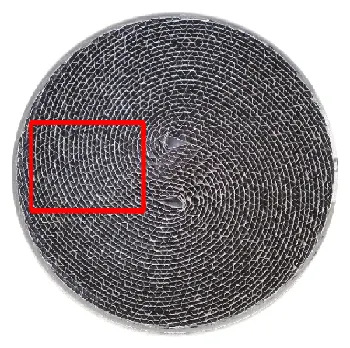
In the scene catalyst dummies are often referred to as "1 cell catalysts". However, this name is more than incorrect, because in this case the cat body would contain more than one cell, which would not be a dummy anymore.
catalyst dummies would therefore have to be called "0 cells catalyst".
OPERATION OF THE CATALYSTS
Due to the incomplete combustion of the fuel in the engine:
- Carbon monoxide CO
- Hydrocarbon HC
- Nitric oxide NOₓ
The 3-way exhaust catalytic converters convert the pollutants in vehicles with petrol engines into
- Water H2O
- Nitrogen N2
- Carbon dioxide CO2
as soon as they have reached a (light off) temperature of 250°C.
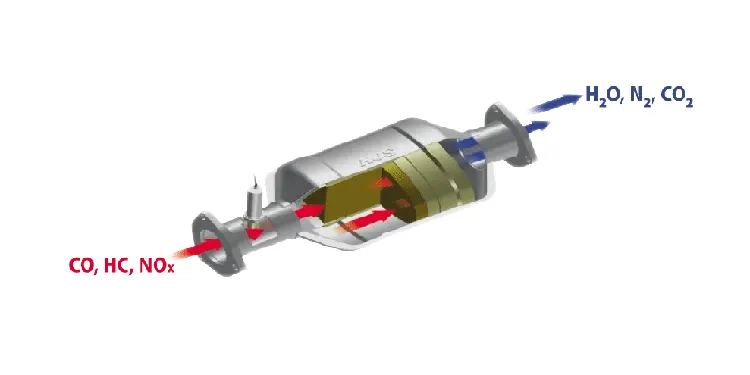
Catalytic converters achieve the optimum effect within an exhaust gas temperature window of 400-800°C and a lambda value of 1.0.
This corresponds to a mixing ratio of 14.7 grams of air to 1 gram of petrol (95ROZ).
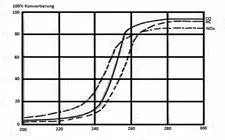
Coating and loading
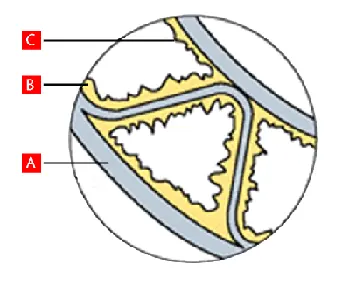
To increase the filtering surface of the catalysts, they are coated with a so-called "washcoat" (B). The resulting porous structure multiplies the surface of the carrier material (A) by a factor of 7000!
This surface is then "loaded" (again coated). As loading (C) the following precious metals in different compositions and proportions are used:
- Platinum (Pt)
- Palladium (Pd)
- Rhodium (Rh)
Platinum and palladium convert CO and HC into carbon dioxide and water. Rhodium enables the reduction of NOₓ to nitrogen. The efficiency of the loads depends on the amount and its composition. They are always expressed in grams per cubic feet (g./ft³).
STRUCTURE OF CATALYSTS
Spiral-Matrix:
- Winding of a flat and a corrugated foil
- The winding centre is the centre of gravity
- Low durability
- Danger of telescoping
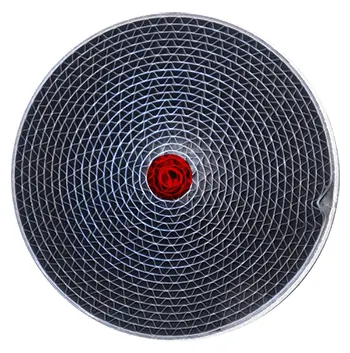
S-Matrix/HF-Design:
- Winding of two flat and 2 corrugated foils
- Two winding centres serve as the centre of gravity
- High durability and resilience
- HJS Technology exclusive for Bull-X exhausts

Damaged catalyst:
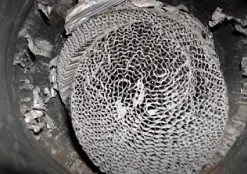
WASHCOAT SINTERING

Washcoat sintering means that when the maximum permissible temperature is exceeded (continuous load), the pore spaces of the washcoat sinter and thus close.
This reduces the catalytic surface and thus the catalyst function.
General causes of EOBD problems:
- Leaks in the exhaust system upstream of the catalytic converter
- Wrong mounting position
- Incorrect catalyst selection (size and emission standard)
- Incorrect installation position of the lambda sensor(s)
- Incorrect mounting of the lambda sensor(s)
- Defective lambda sensor cables
WHAT IS A CATALYST DUMMY?
A dummy cat is a catalytic converter housing which is empty, i.e. does not have a honeycomb body and the corresponding coating and its properties.
A dummy cat is only meant to give the impression that a catalyst is present.
The lack of conversion of the pollutants can lead to errors in the engine electronics, especially in newer vehicles, because the lambda sensors produce incorrect values.
In addition, the installation of a dummy catalytic converter represents an attempt at tax evasion if the vehicle is used on public roads, as the vehicle tax relates to the actual exhaust emission standard of your vehicle. If your emission standard deteriorates because you do not have a catalytic converter, you would theoretically have to pay more vehicle tax.
Dummy catalytic converters are generally not permitted in the STVZO area.
WHAT IS A CATALYST? The honeycomb bodies of the catalytic converters, which are made of ceramic or metal, serve to increase the surface area over which the exhaust gas flows as much as...
read more » Close window Sportcatalyst FAQ
WHAT IS A CATALYST?

The honeycomb bodies of the catalytic converters, which are made of ceramic or metal, serve to increase the surface area over which the exhaust gas flows as much as possible in order to ensure the best possible course of the reaction.
If you want to replace your original catalytic converter with a sport or tuning catalytic converter, the following should be considered in advance for optimal functioning:
The choice of a suitable sports catalyst should generally be made in accordance with the engine capacity, performance and exhaust emission standard.
Furthermore, it is recommended that the sports catalytic converter and the lambda sensors are always installed in their original positions in order to guarantee the efficiency of the catalytic converter, as it requires a certain temperature during cold-running/cold start to work correctly.
Surely you know the names like 100 or for example 200 cells catalysts. This designation is known in professional circles as cells per square inch = cpsi.
This means that an area of 2.54cm x 2.54cm (as shown) for a 200 cell cat contains 200 cells. It is a widespread misconception that the cat body has a capacity of only 200 cells on the entire surface when 200 cells are specified.

In the scene catalyst dummies are often referred to as "1 cell catalysts". However, this name is more than incorrect, because in this case the cat body would contain more than one cell, which would not be a dummy anymore.
catalyst dummies would therefore have to be called "0 cells catalyst".
OPERATION OF THE CATALYSTS
Due to the incomplete combustion of the fuel in the engine:
- Carbon monoxide CO
- Hydrocarbon HC
- Nitric oxide NOₓ
The 3-way exhaust catalytic converters convert the pollutants in vehicles with petrol engines into
- Water H2O
- Nitrogen N2
- Carbon dioxide CO2
as soon as they have reached a (light off) temperature of 250°C.

Catalytic converters achieve the optimum effect within an exhaust gas temperature window of 400-800°C and a lambda value of 1.0.
This corresponds to a mixing ratio of 14.7 grams of air to 1 gram of petrol (95ROZ).

Coating and loading

To increase the filtering surface of the catalysts, they are coated with a so-called "washcoat" (B). The resulting porous structure multiplies the surface of the carrier material (A) by a factor of 7000!
This surface is then "loaded" (again coated). As loading (C) the following precious metals in different compositions and proportions are used:
- Platinum (Pt)
- Palladium (Pd)
- Rhodium (Rh)
Platinum and palladium convert CO and HC into carbon dioxide and water. Rhodium enables the reduction of NOₓ to nitrogen. The efficiency of the loads depends on the amount and its composition. They are always expressed in grams per cubic feet (g./ft³).
STRUCTURE OF CATALYSTS
Spiral-Matrix:
- Winding of a flat and a corrugated foil
- The winding centre is the centre of gravity
- Low durability
- Danger of telescoping

S-Matrix/HF-Design:
- Winding of two flat and 2 corrugated foils
- Two winding centres serve as the centre of gravity
- High durability and resilience
- HJS Technology exclusive for Bull-X exhausts

Damaged catalyst:

WASHCOAT SINTERING

Washcoat sintering means that when the maximum permissible temperature is exceeded (continuous load), the pore spaces of the washcoat sinter and thus close.
This reduces the catalytic surface and thus the catalyst function.
General causes of EOBD problems:
- Leaks in the exhaust system upstream of the catalytic converter
- Wrong mounting position
- Incorrect catalyst selection (size and emission standard)
- Incorrect installation position of the lambda sensor(s)
- Incorrect mounting of the lambda sensor(s)
- Defective lambda sensor cables
WHAT IS A CATALYST DUMMY?
A dummy cat is a catalytic converter housing which is empty, i.e. does not have a honeycomb body and the corresponding coating and its properties.
A dummy cat is only meant to give the impression that a catalyst is present.
The lack of conversion of the pollutants can lead to errors in the engine electronics, especially in newer vehicles, because the lambda sensors produce incorrect values.
In addition, the installation of a dummy catalytic converter represents an attempt at tax evasion if the vehicle is used on public roads, as the vehicle tax relates to the actual exhaust emission standard of your vehicle. If your emission standard deteriorates because you do not have a catalytic converter, you would theoretically have to pay more vehicle tax.
Dummy catalytic converters are generally not permitted in the STVZO area.